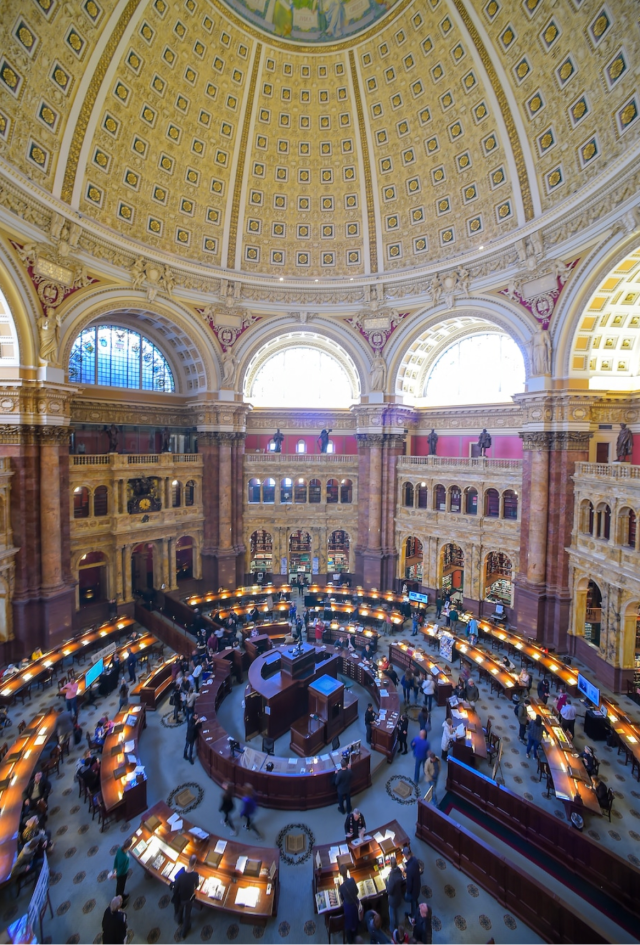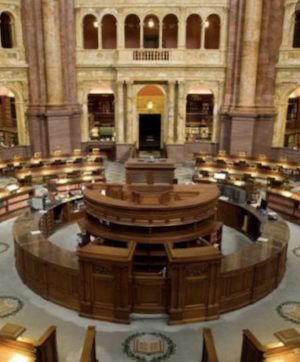
View of the dome of the Library of Congress along with the circulation desk below. (Washington Post)
The spirit of the Jefferson Building of the Library of Congress trembles as the institution’s leadership proposes $60 million in renovations, including the removal of the circulation desk in the middle of its Main Reading Room.
The D.C. Preservation League has placed the Jefferson Building, which sits across Independence Avenue from the U.S. Capitol, on its annual list of endangered places. The DCPL warns against the renovation plan, which, it says, envisions:
the complete removal of its historic Center Desk, to be replaced by a circular window in the floor (“the oculus”) so that tourists below could look up through it at the Reading Room’s dome.
The principal deputy librarian of Congress, Mark Sweeney, claims that the desk’s removal will not be complete. Instead, as the Washington Post reports:
The plan does not remove the entire circulation desk as preservationists contend, [Sweeney] added. The outer circular wooden structure will remain, while the inner desk, which Sweeney calls the tower, will be disassembled, inventoried and stored.
Yes, but as Sweeney admits, gone will be the tower, the desk within the desk, originally erected when the building was completed in 1897. The tower provides an important part of the desk’s historic character, not to mention its functionality.
Wags no doubt are already wondering whether female librarians will be urged to wear pants suits rather than dresses that might expose them to the prurient observation of tourists looking up from below through the new glass “oculus.”
But, to be just a bit more serious, the Preservation League (and others who oppose changing the circulation desk) are correct to object to this and probably other aspects of the renovation. In the nature of things, these changes will likely be done poorly if they are not blocked. Just because it is the Library of Congress doesn’t exempt it from any or all of the flaws of modern-day architecture, even when it seems to be “historic.”
All such renovations to beautiful old buildings should be opposed on principle. That is the job of preservationists. Tourists in the great library are fine, but they will enjoy the building, and any historic structure, more if it is kept as much as possible in its original state.
As a young man, my brother Guy used to work in the Madison Building of the library nearby, and I would walk through the Jefferson Building on my way to visit him. Occasionally I would use the library for my own purposes, waiting for one of the librarians to roll by with a cart of books or articles for my perusal. My memories of the reading room are fond. I hope time will calm its spirit, at least until the next bout of proposed “renovations” arrives to haunt the place.




Why must we put up with these stupid things. I thought we had fought the good fight at NYPL, but now it appears we have to do it again in Washington.
LikeLike
Sadly, most of what you say, John, is on target.
LikeLike
Hyperdemocracy, ever more interference by the masses (see Ortega’s: Revolt of the Masses). Opening the library to the public long ago was already a mistake, but at that time the population was not so large as these days, and there was not yet a luxury proletariat being able to afford so much gaping and photographing-of-themselves leisure time. The public was also still humble in these times, while in hyperdemocracy, they feel to be kings, and are treated as kings, if such demagogy comes in handy. Allowing tourists (= the masses) to gape into the library like this,to see the dome, is just another small step in the process of hyperdemocracy, which tendentious bunglers will gladly facilitate. Hyperdemocracy has no use of tradition, except when it can be used to amuse and entertain the masses, the contemporary luxury proletariat.
LikeLike